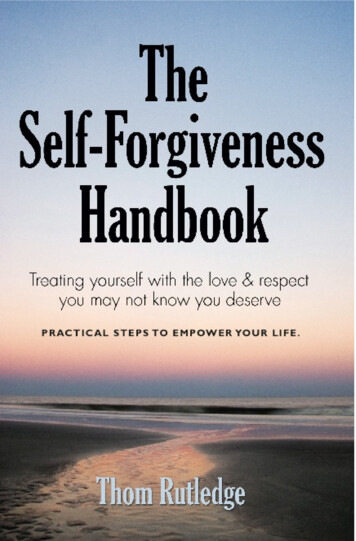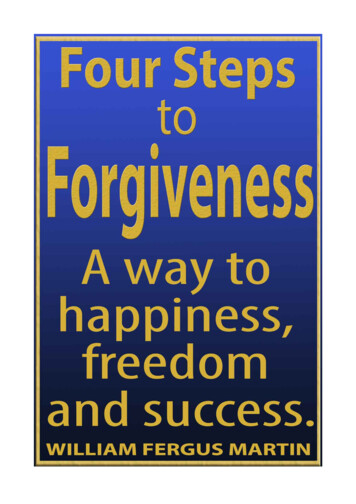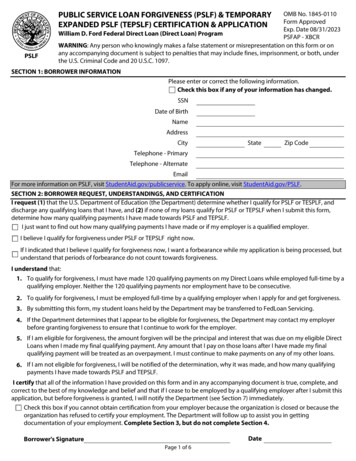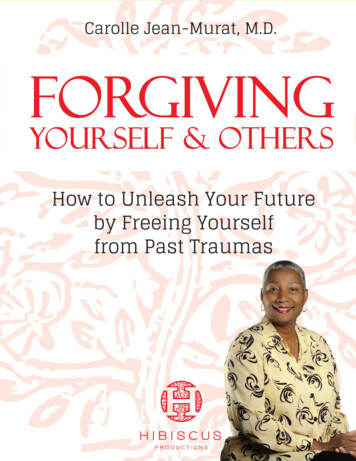
Transcription
A step-by-step guide to overcoming damaging self-criticism, developing acompassionate relationship with the self, and living a more positive andproductive life, free of the committee of internal voices that dismiss strengths andmagnify blunders and mistakes. Based on the author's inspiring "self-imageworkshops," The Self-Forgiveness Handbook takes readers through a program ofguided exercises that introduce and reinforce the seven essential components ofself-forgiveness and personal responsibility.The Self-Forgiveness HandbookOrder the complete book s/7949.html?s pdfor from your favorite neighborhoodor online bookstore.Your free excerpt appears below. Enjoy!
THESELF-FORGIVENESSHANDBOOKTreating yourself with the love & respectyou may not know you deserveTHOM RUTLEDGEAuthor of Embracing Fear
Copyright 2015 Thom RutledgeISBN 978-1-63490-208-3All rights reserved. No part of this publication may be reproduced,stored in a retrieval system, or transmitted in any form or by anymeans, electronic, mechanical, recording or otherwise, without theprior written permission of the author.Published by BookLocker.com, Inc., Bradenton, Florida, U.S.A.Printed on acid-free paper.BookLocker.com, Inc.2015First edition was published asThe Self-Forgiveness HandbookNew Harbinger Publications 1997
Introductionorgiveness is a concept more often associated withFspirituality than with psychology, or at least that’s how itused to be. Increasingly --- over the past twenty-five orthirty years --- the line of demarcation between spiritualityand psychology has blurred. For the purist from either nedpsychotherapist’s world is contaminated with the introduction ofspiritual concepts (especially those that defy rationalexplanation) such as forgiveness, soul, and God. For the deeplyreligious, the insistence on scientific principle associated withpsychological theory, not to mention the tendency to notnecessarily honor mother and father, can be offensive.In as much as the two disciplines can still bedistinguished from one another, this is a book of psychology.Herein we well examine the psychology of the relationship of theSelf with the Self. For some readers, this will quite naturallyinvolve their spirituality, but there is no prerequisite beliefsystem to benefit from The Self-Forgiveness Handbook. All thatis required is a desire to feel better about yourself and your life.Too often, self-help books dwell predominantly on theexplanations of how we became so well, in need of self-helpbooks, and then devote only a few chapters (toward the end ofthe book) about how we might recover from our now wellunderstood dysfunction. I want The Self-Forgiveness Handbookto be of practical use to you beginning with page one, chapterone. I want this book to be a box of tools you can learn to use --with practice --- to make a real difference in your life.Certainly, it is important to understand how we got frompoint A to here. After all, those who do not remember --- andunderstand --- the past are doomed to repeat it. I think you willfind plenty of explanation within these pages about what makessomeone need a book on self-forgiveness. But there is no needto put off the work of change to the final chapters. In fact,1
Thom Rutledgeconsidering the negative bias that most of us have towardourselves, it is difficult to imagine how we can becomeobjectively understanding, let alone empathic, until we at leastlearn to stop attacking ourselves at every turn.In a way learning self-forgiveness is the classic humansearch for identity. As long as we remain in hiding from the socalled negative aspects of ourselves, we remain incapable ofembracing all of who we are. When we consider only certain ofour human characteristics acceptable, we have no choice but toremain fragmented, experiencing ourselves as less than whole.And since rejecting certain aspects of ourselves does notexorcise them from our personalities, we find ourselves in astagnant pool of guilt (for having such unsavory traits) that, leftalone, will become at least the toxins of self-distrust and dislike,and possibly the poisons of self-disgust and hatred.In one sense, all of this may come to pass due to a sortof collective ignorance, a void of essential information in oursociety. Sure there are many negative, not to mention untrue,things we are taught to believe as we grow up. And destructive,false beliefs will need to be confronted and transformed. Butnone of these may prove as harmful as one big missing piece ofdevelopmental information: in our society, historically, we havenot been taught the importance of maintaining a positive, lovingand respectful relationship with ourselves. In fact many of ushave been actively discouraged from such a self-compassionatestate, learning instead that to care for ourselves is selfish.If we were not taught this essential component of goodmental health --- that self love is good and necessary --- it is forone reason: those who taught us could not teach what they didnot know. There is no master plan for one generation to destroythe next; it is a matter of legitimate ignorance and/or inadequateapplication of knowledge.If you take the risk of believing this to be true and decidethat you can learn to forgive yourself, there will be manyobstacles along the way, but none as daunting as those that youwill discover within your own consciousness. Some beliefs you2
The Self-Forgiveness Handbookwill gladly release, and others will be strangely difficult to let goof. This book will provide a quality set of tools (instructionmanual included) for the task of identifying and confrontingthose internal obstructions.At the blatant risk of mixing metaphors (I am certain that Iwill eventually have to attend Analogies & MetaphorsAnonymous) this book is also intended to provide a practicalmap to help you navigate your way from here to wherever youchoose to be.How to Get the Most Out of This BookThe Self-Forgiveness Handbook is presented in four parts. Part1 provides what I consider to be the essentials for your selfforgiveness toolbox --- the hammer, pliers, screwdriver, andwrench, so to speak. They will help you explore your personalthoughts and feelings about self-forgiveness. Pare 1 ends withwhat some of my clients have called my “sermon” about thehealing power of awareness. (When we can learn to slow downour thinking enough to take a more accurate look at what isgoing on around us and within us, everything changes. Amen)Part 2 introduces you to the seven components of selfforgiveness. Chapter 4 makes the introductions --- Reader,these are the Seven Components; Seven Components, this isthe Reader --- and the subsequent chapters guide you in anexploration of each component. The response I have receivedfrom clients, workshop participants, audiences, and readers isthat once this material is experienced, it becomes impossible tomaintain an exclusive hold on your old negative self-image.I think it works something like the “Hidden Pictures” gamein the children’s magazine, Highlights: you search and searchand search for the image of the shoe, and you can’t find itanywhere, from any angle. You have already found the duck,the thimble, the umbrella, and the puppy, but no shoe. Then,just when you are about to give up, your gaze relaxes, you sitback and there, clear as the sky on a cloudless day, right in the3
Thom Rutledgemiddle of the big tree is the shoe. Once discovered, it becomesimpossible to not see the shoe. And so will be your experiencewith part 2 of this book. You will no longer be able to escapeyour new awareness of your “committee,” your “shouldmonster,” and your “decision maker.” And you will be stuck withthe ability to recognize when you are giving away, or throwingaway, your personal power.Part 3 is a natural extension of part 2. These chaptersidentify common problems encountered when applying theseven components to day-to-day life in the real world. Betteryet, these chapters also suggest solutions to those commonproblems.Part 4 is a bit of a departure --- from the rest of the bookas well as from the average self-help book --- at least in how it ispresented. Each section is a brief essay addressing, or posing,some question related to living a life of self-compassion. Theseessays were fun to write, and I hope that you will enjoy readingthem. I am a card-carrying, charter member of the If You Don’tHave a Sense of Humor, You Had Better Get One or You Are inBig Trouble Here on Planet Earth Club. Nowhere in my policyand procedure manual does it say that as we struggle to freeourselves from the tyranny of self-criticism, we shouldn’t have alittle fun along the way.Part 4 is also a departure in that it dabbles in topics thatare probably beyond the scope of this book. But I have nevertended to color inside the lines and don’t believe that we caneffectively discuss the subject of forgiveness without at leastacknowledging the philosophical and spiritual implications.Keeping a JournalA little writing can go a long way as you explore yourrelationship with this powerful and elusive thing calledforgiveness. Hopefully what I (and others) have to say on thesubject can be useful, but it can only be so to the degree thatyou are committed to remaining aware of what you think, feel4
The Self-Forgiveness Handbookand believe. Your experience is what counts. Keeping a freeflowing journal is a tangible way of tracking and enhancing yourexperiences along the way.If you don’t already keep a journal, and if you think itwouldn’t make that much difference, I strongly recommend thatyou find a notebook of some kind --- one that you like the look,size, weight, and fee of --- and write in it as you read The SelfForgiveness Handbook. Use your journal to do the writingexercises you will find throughout the book, but don’t stop there.Don’t just take your direction from me. Your greatest wisdom,your greatest authority is not in me and not in this book. Nor willyou find it in any other teacher or book. Your truth is inside you,and putting pen to paper when you don’t have the slightest ideawhat might come out is an invitation for that truth and wisdom toemerge. An honest journal will always reflect that you are awork in progress --- as are we all.Here is a helpful hint about The Self-ForgivenessHandbook. Parts 1 and 2 will be most useful if read insequence; these chapter4s are the foundation for your dailypractice of self-forgiveness. But read parts 3 and 4 in any orderyou wish, whenever you feel the need for a little reinforcement.These chapters are like golf clubs: choose the one you needdepending on where you find yourself along the fairway.Think of your journal as a workbook. Don’t treat it toogently; don’t be afraid to scribble in it or write in the margins. Ajournal is you work space, and it has only one purpose: torecord your thoughts and your feelings --- the positive and theso-called negative, the vague and the precise, theunderstandable and the confusing. These are all parts of thesame whole: you. The totally acceptable, forgivable andresponsible you.5
PART ONEThe EssentialsOur capacity to make peace with another person and with the worlddepends very much on our capacity to make peace with ourselves.—Thich Nhat Hanh,Living Buddha, Living Christ
Chapter 1What Self-Forgiveness Isand What It Isn’tFirst, this is not a book about playing God. I have a goodfriend, a devoted Christian, who (when she heard the title tomy new book) told me that I was going to be “treading onshaky ground.” Initially, I was surprised by her response, but aswe talked I came to understand that her belief—and thereforeobjection to my book—was that only God can forgive. But theexploration of all the philosophical and theological questions thatraises is a whole book in itself.If your religious or spiritual beliefs are similar to myfriend’s, I encourage you to think of The Self-ForgivenessHandbook as a guide to help you learn how to effectivelyreceive forgiveness. What we are given, from God or from eachother, is of no use unless we can learn to accept the gift(s).Those of us who would read (or write) this book will have atleast one thing in common: we have all had difficulty acceptinggifts, be they compliments, attention, love, or peace of mind.Most of us cannot trust good things to be genuine, or if weaccept that they are genuine, we don’t trust them to last. Ofcourse this doesn’t even touch upon the question of whether ornot we feel we deserve the good things.Consider the various dangers: the danger of seekingsomething you are sure you don’t deserve; the danger ofgaining something you will certainly lose; the danger of believingthe best of yourself while still falling short of your personalexpectations; the terror of genuinely accepting your humanimperfection, letting go of the dangerous double standard bywhich you measure only yourself.9
Thom RutledgeThis book is about facing these dangers, daring to treadon that shaky ground—and living to tell the story. To openyourself to forgiveness is a frightening proposition. Butremaining closed to forgiveness is not such a great optioneither.The bottom line is, learning to forgive yourself is not forthe faint of heart. To learn—and maybe one day to master—forgiveness and compassion as a way of life, you will needplenty of willingness to take risks, an excellent sense of humor,enormous portions of persistence, and plain, old-fashioned guts.The good news is that I will help you to discover and enhancethese and many other necessary tools along the way.If your experience with religious or spiritual beliefs hasbeen harsh or frightening, and is contributing to a negative viewof yourself, try approaching this material as an aid to detoxifyingfrom archaic beliefs that depict you as, somehow by your verynature, sinister and undeserving. Such beliefs only serve toterrorize and paralyze; they do not pave the way to a life ofserenity and personal acceptance as they claim.What Self-Forgiveness IsA common fear—and criticism of self-help psychology—is thatself-forgiveness is a snazzy, politically correct, sociallyacceptable way of letting ourselves off the hook by avoidingaccountability and personal responsibility. This is absolutely nottrue. In fact, as we will explore throughout this book, the morepowerful and accurate definition of forgiveness is quite theopposite; self-forgiveness is the natural starting place foranyone who wants to lead an ethical life as free from hypocrisyas is humanly possible.Think of it this way: When I was a kid, my father owned adry-cleaning store. As an adolescent, I drove his delivery truck,picking up and delivering dry cleaning all around the small townwhere I grew up. In essence, I drove my Dad’s truck aroundtown, working to meet the needs of other people, my Dad’s10
The Self-Forgiveness Handbookcustomers. Was my father selfish for taking excellent care ofthat truck? Was he being selfish to make sure its tank was full,that the oil was changed on schedule, and that the tires werealigned?Of course not; my Dad’s priority care of that truck was notabout being selfish. It was about being smart. Without regular,quality maintenance, the delivery truck would eventually requiremuch more time and attention, not to mention money, than hecould afford. People are the same way.Self-forgiveness is that regular maintenance that keepsus on the road. The self-forgiving person is not—as manybelieve, or at least fear— a selfish person. It is the person whoremains stuck in self-doubt and self-condemnation who will leadthe more selfish, less productive life. As a psychotherapist, Ihave learned this lesson well. The better I take care of myself,the more effective I will be with clients and workshop audiences.When I have a noisy, neglected engine rattling under my hood, Iwill be distracted and unfocused on the work at hand. When I“run out of gas” I won’t be able to show up (mentally). Selfforgiveness keeps us from being stuck; it keeps us moving.What I BelieveLet me tell you what I believe about forgiveness, and inparticular, self-forgiveness. First, I believe that all growth movesfrom the inside out, and that our repetitious, and very human,attempts to resolve problems from the outside in are just what(on closer examination) they appear to be: backwards.I believe that in years past if I were to love my neighboras myself, my neighbor had better watch out.The first part of any conflict that I must resolveis that which is between me and me.I believe that self-compassion is our first nature, and thatexcessive self-criticism and self-condemnation are a learned11
Thom Rutledgesecond nature. I believe that forgiveness—of ourselves andothers—is not so much something we do, as it is that naturalstate when we are not holding on to old resentments, pain, andguilt. I also believe that resentments and grudges I hold againstmyself are every bit as destructive as those I harbor for thefellow down the street.I believe that living a life of self-compassion has nothingto do with being selfish, or in any way excluding others. I believethat the first step to giving is receiving; that when we aregenuinely self-forgiving, the benefits automatically (or withminimal effort) spill over into the lives of others. When wepractice genuine self-forgiveness, we will naturally liveaccording to a positive value system that includes respect for—and a desire for—the well-being of others.I believe that in order to practice genuine selfforgiveness, we must accept full responsibility for who we areand what we do. Accountability is a requirement, and perfectionis not even an option.Finally, I believe that living a life of forgiveness, attendingto daily life from the inside out, is the most energy efficient andmost productive way to live. I believe that self-forgiveness isessentially inseparable from self-respect and self-responsibility.What This Book Is and Is NotIn no way is this book an exhaustive and comprehensive studyof forgiveness. As you read, bear in mind that these are oneman’s ideas and beliefs about forgiveness. This material isbased as much on my experiences in learning to forgive myselfas it is based on my teaching and clinical experience workingwith clients and workshop participants.I have never trusted anyone who claimed to have theultimate answers, and so my promise (and a sort of disclaimer, Iguess) to you is that I will not claim to have the answers. Isincerely believe that all any self-help book, workshop, orpsychotherapist can do is offer support (“You are not alone”),12
The Self-Forgiveness Handbookguidance (“Have you ever tried going down this road?”),validation (“You have a right to be in charge of your own life”),and positive confrontation (“Like it or not, you are in charge ofyour own life”).Like good psychotherapy, I want your experience withThe Self-Forgiveness Handbook to be collaborative. Take whatis helpful; leave what is not. But I encourage you to take timewith the ideas and the exercises that follow. Try them on—asopposed to viewing them from a safe distance. Then ifsomething doesn’t fit, leave it. But if something does fit— be itshoe or otherwise—it’s yours. And it will be your choice to wearit or not.And please don’t be afraid to argue with and question thisbook. Allowing the more restless, even rebellious parts ofyourself to participate, as you will read about later, is animportant part of learning how to forgive yourself. In many ways,we have learned to accept only select aspects of ourpersonalities, and to reject others.For example, “I’m okay as long as I’m doing somethinghelpful for someone else, but it is selfish of me to pursue myown interests. The anger that I feel is wrong. I should be happyand grateful.”In my book, every part of you is welcome. Come one, come all.Moving Toward Self-ForgivenessThroughout many years of involvement in the process ofpersonal growth --- as a psychotherapist, as a client inpsychotherapy, and as a self-help explorer --- I have returnedagain and again to one central awareness: The key to genuine,long-lasting change lies not in the resolution of any particularcircumstance, but in developing the ability to forgive oneself.As a psychotherapist I probably spend 80 percent of mytime redirecting clients’ attention from the content, orcircumstances, of their lives to the process of their relationshipwith themselves. It is the proverbial choice between giving13
Thom Rutledgesomeone a fish and teaching someone how to fish. I can chooseto approach my clients as a collection of problems, and set outto help solve those problems one by one, or I can approach myclients as problem solvers, and enter into a collaboration withthem to improve their ability to solve their own problems. Thelatter has always made much more sense to me.And of all the possible problems that problem solversmight encounter, there is one that seems to rise above all of therest again and again: inappropriate and excessive self-criticism.Journal Exercise: What I BelieveAt the top of a page write, “What I Believe about Forgiving Myself.”Then make a list, each time completing the sentence “I believe ”Remember to let the associations run free. Write whatever comes toyou mind without judgment --- as much as that is humanly possible.And don’t be concerned if you discover seemingly conflicting beliefs.These are very common, even useful, as you will see in Chapter 6.Your page will look like this:What I Believe about Forgiving MyselfI believeI believeI believeEtc.The Attentive SupervisorImagine that you and I are sitting in a room together and that Igive you a task to perform; let’s say the task is to complete thejournal exercises in this chapter. As you begin, I lean in closeover your shoulder, watching your every move. As you attemptthe written task, I talk to you constantly, critiquing everythingyou write as you write it. I sigh heavily to express mydisappointment. I clear my throat, obviously casting doubt onthe sentence you’ve just completed. I remind you that you are14
The Self-Forgiveness Handbookprobably not doing the exercise correctly and that you neverhave been any good at following directions, not to mention (but Ido mention it) that you’re not a very good writer and, while we’reon the subject, don’t forget that your handwriting is horrendous.If the task was difficult to begin with, my “attentivesupervision” will make it impossible. If the task is simple to beginwith, my oh-so-helpful sounds and comments will make it farmore difficult and complex than it needs to be.Does any of this sound familiar? If so, it could mean thatyou’ve had a boss, a teacher, a parent, a friend, or a spouse likethis. It could mean that you were taught to think of God like this.It very likely means that with or without outside assistance, youhave tended to treat yourself in this constantly critical way. Sure,you may discover that you need some help with the originaltask, but you really can’t know that until there is a significantchange in your style of supervision.In the simplest terms, that is what I do for a living: I teachpeople how to respect, protect, support, and even likethemselves. And when that is accomplished (which is no smalltask), there are not many problems that cannot be solved. It’samazing how much you can get done when you are not havingto look over your shoulder every other minute to see if that bullyof a supervisor is coming.When we let go of constant attempts to solve the contentof our lives, and attend to the important process of how wetreat ourselves and each other, we have a real chance forpeace of mind.The key to quality, lasting change is the presence of selfcompassion. With that awareness as a starting point, over theyears I have distilled into seven categories what I have come toconsider the basic components of self-forgiveness.The best part is that these seven components are notspecific to any one problem area. If you are depressed, if you15
Thom Rutledgeare anxious, if you are concerned about addictive or compulsivebehaviors with food, drugs, alcohol, relationships, and so on, thecomponents act as a map that can guide you to the informationand insights you will need in order to face and resolve yourproblems. These are fishing lessons. What you decide to catchis entirely up to you.Respecting YourselfGoing toe to toe with your problems (many of which you mayhave been sidestepping and ducking for years) is a frighteningprospect. But with “map” in hand, plus the lessons you will learnfrom this book, a tangible sense of hope will join yourunderstandable fear. And hope and fear are not, as they mayinitially appear, opposites. They are, instead, old buddies—traveling companions. You will seldom find one without theother.Journal Exercise: Hopes and FearsMake a list of some of your hopes --- and the fears that willaccompany them.The seven components are also a viable set of tools formaintaining your successful changes. Forgiveness is never aone-time event; if it does not become a way of life, it is nothing.But when you learn to live a life of self-forgiveness, everythingchanges.Specifically, self-forgiveness will allow you to gather yourdreams, your desires, and your courage to live the life youchoose to live, the life you want to live. But what do you want?This is not necessarily an easy question to answer. If you havegrown up learning to value being hard on yourself to the point ofself-induced martyrdom or self-condemnation, it will not besurprising to find that the idea of “what you want” was sweptunder the rug long ago.16
The Self-Forgiveness HandbookA friend of mine offers an interesting explanation for thisproblem from a developmental vantage point: Children are notwelcomed into the world and brought up with enough curiosityfrom the adults around them. My friend says that there areessentially two opposing metaphors for parenting: Children are clay, and parents are the sculptors. Aparent’s job is to mold the child into the person the parentbelieves it is best to be. Children are seeds, and parents are the gardeners. Thejob of a parent is to care for the environment in which thechild will grow—providing the proper conditions for “theseed” to grow into whoever he or she is.Learning self-forgiveness will change youfrom the inside out, creating a power ripple effect.The lack of curiosity adults have about who children areis an inadvertent, but habitual, expression of disrespect.(Respect being defined as the conscious recognition ofanother’s individuality.) The sculptor-parents (and otherteachers) interact with children predominantly in one direction:parent to child, teacher to student. Genuine curiosity is missing,or at least in short supply.Open minded curiosity about another person’sperspective is a powerful expression of respect.Consider the alternative: Adults who accept responsibilityfor creating and maintaining a safe and ethical environment inwhich children can experience permission and freedom todiscover for themselves who they are, what they enjoy, wheretheir abilities lie, and what they want. Parents and teacherssecure enough in themselves to have faith in their children, andwho can approach child rearing with curiosity, wondering withenthusiastic interest, “Who will she be?” or “What will he beinterested in as he grows up?”17
Thom RutledgeIn this kind of healthy environment, children learntolerance for imperfection (theirs and others); they learn to takeappropriate risks in their efforts to explore the world aroundthem; they learn to succeed; they learn that when they fail, thereis no need to surrender their self-esteem. This is the naturalstate of a child. With self-forgiveness, we will rediscover thatnatural state in ourselves.Facing the ObstaclesFor all of your potential, there will be many obstacles along theway. Fear of the unknown and a sense of not knowing what youwant are only two examples. But you can do this. I have. And Ihave witnessed many others do this work and reap the rewards.When in doubt, think of the wonderful movie, The Wizardof Oz (1939). Dorothy, the Scarecrow, the Tin Man, and theCowardly Lion combined their strengths to overcome whateverwas put in their path by the Wicked Witch of the West. Along theway, each of the travelers faced a sense of hopelessness, andwhen they did, the others were there with the encouragementneeded to keep the hope alive. Ultimately they succeeded infinding the Wizard. And when they did, they discovered thatwhat they were seeking, what each of them wanted more thananything, had been a part of them all along.Children are seeds. And seeds are pure potential.Self-forgiveness is like searching for the Wizard: whenyou get there you will know that you have always had a brain, aheart, courage, a home—whatever you want more thananything. It’s right there inside of you. (You don’t have to believeme now. Just keep reading.) And we are each other’s Dorothy,Scarecrow, Tin Man, and Lion, here to remind each other tokeep hope alive.18
The Self-Forgiveness HandbookJournal Exercise: Off to See the WizardAnswer these questions to the best of your ability. Your answers canbe in the form of a paragraph, a list, a poem, a story --- whatever formfeels right for you.In what ways were you brought up by “sculptor-parents?”In what ways were you brought up by “gardener-parents?”Are you more of a sculptor or a gardener in your relationship withyourself?What makes you curious about yourself?What do you want from the Wizard?19
Chapter 2Self-Forgiveness andPersonal ResponsibilityThe yellow brick road may have been a romantic journey,but it was not an easy one. The Wizard has the power, aswe all do, to point out what is already true. He does nothave the power to make true what is not. I do not claim Wizardstatus, but very often, as a psychotherapist, my job boils downto just that: pointing out to my clients w
the book) about how we might recover from our now well-understood dysfunction. I want The Self-Forgiveness Handbook to be of practical use to you beginning with page one, chapter one. I want this book to be a box of tools you can learn to use ---










